Avoid Domain Authority Manipulation When Buying Domains & Backlinks
If you’re doing any of the following:
-
- Buying backlinks for better rankings in the search engines
- Looking to buy an SEO friendly domain with a high domain authority
…Then you really need to read this.
Why? Because there’s an extremely unethical practice going on, right now.
Well, I say “unethical practice” but it’s basically a flat-out scam.
I’ve fallen for it multiple times, and if you’re doing any of the above, you may have too.
So what’s this scam that involves buying backlinks and domains?
Well, it has everything to do with a popular SEO metric people use to gauge the importance of backlinks and domains.
And that is, the domain authority metric.
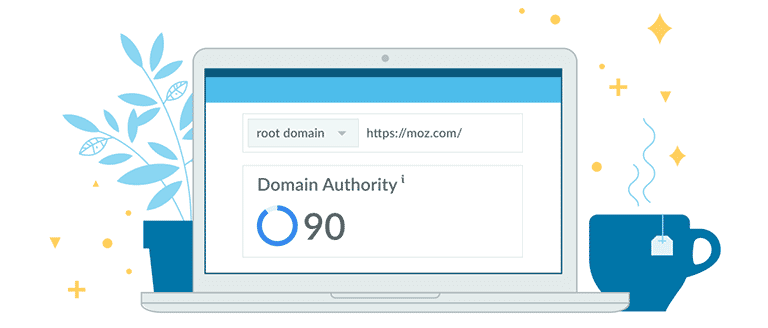
Personally, I normally use Moz’s domain authority, but this also applies to the equivalent metrics used by competing SEO companies as well.
So whether you’re using:
-
- Ahrefs’ domain rating
- SEMrush’s domain authority score
- Ubersuggest’s domain score
- Majestic’s trust/citation flow
…Then these are affected by what I’m about to tell you as well.
Like I said, domain authority is the go-to metric to gauge the overall power of backlinks and domains.
Generally, the higher the domain authority, the more powerful the backlinks will be and the easier the domain is to rank.
There is other metrics to consider when analysing domains, but domain authority is great if you just want a at-a-glance SEO strength of a particular domain or how beneficial backlinks are from a specific site.
So what’s the problem with domain authority metric?
Well, as good as domain authority is, it can unfortunately be easily exploited using a particular technique.
What this technique does, it artificially inflates the domain authority rating of a particular domain it’s been deployed on.
However, no matter how high you inflate the domain authority score using this method, it has zero benefit from an SEO point of view.

For example…
You could artificially inflate a DA1 site to a DA90, but it would still only have the actual ranking power of a DA1 website.
Basically, it looks amazing on paper but it falls flat on its face when it comes to delivering real world results in Google.
Obviously, scammers have latched onto this method and it has allowed them to charge premium prices for otherwise worthless backlinks and domains.
Despite this domain authority manipulation technique been used by scammers for years, it’s only something I’ve recently stumbled across.
The first time I came across it was around 6 months ago on Fiver.com…
I noticed tons of Fiverr gigs that would boost your site’s domain authority score to DA50 or better.
Here’s one of them:
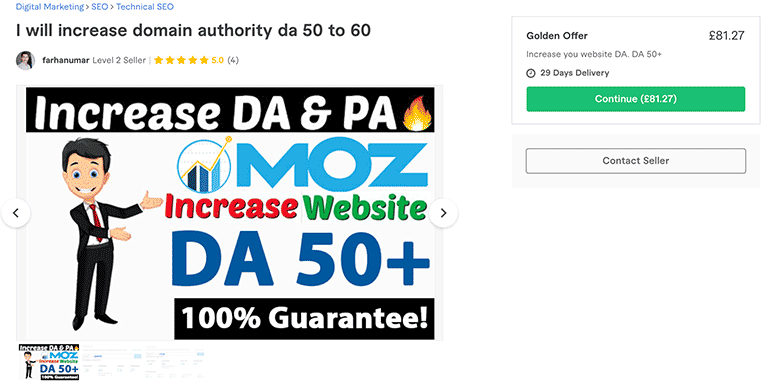
Knowing what I knew at the time, I knew this would be no easy feat using traditional methods…
It would involve getting tons of high quality backlinks from authoritative sites which is a time consuming process, and like I said, not easy to do either.
…It would definitely be worth considerably more than what these guys were charging, that much I do know.
As it goes, I knew one of the guys who was selling these domain authority boosting gigs on Fiverr. I decided to hit him up to see what I could learn about this method…
He told me this method would boost the domain authority rating on any website it was used on.
However, he also told me regardless how high you increase the domain authority, it’ll make absolutely no difference when it comes to ranking your website in Google.
So not only are scammers using this to artificially increase the metrics of backlinks and domains, but people are doing it to their own websites… Just so they can have a high domain authority rating.
Kinda pointless in my opinion as it’ll make zero difference in Google but each to their own, I guess.
How is the domain authority artificially manipulated?
All this technique involves is getting lots of redirect links from Google owned websites.
I don’t know the exact process on how get these Google redirect links because I’ve never looked into it myself.
Mind you, it’s very easy to spot a domain that has been manipulated when you know what to look for.
I’ll give you an example…
Let me introduce you to a website called Fotolog.com.

Fotolog.com is basically an article based website that covers topics in every conceivable market, out there.
Now a big chunk of Fotolog’s income comes from selling guest posts.
So basically, Fotolog.com is in the business of selling backlinks from their website.
At the time of writing this post, Fotolog.com has a 86 domain authority rating – which is very impressive, I must admit.
With Fotolog.com having a high domain authority rating, getting a contextual dofollow backlink from their site would be a very desirable prospect from an SEO point of view.
As a result, Fotolog.com can charge considerably more for their guest posts due to the perceived SEO value their links will have.
So the question is, how did Fotolog.com get this insanely high domain authority rating?
Well, lets dig a little deeper, eh…
Using Moz’s Link Explorer, we can analyse Fotolog’s backlink profile and see the kind of links they have pointing back to their site.
If we look at the graph for Fotolog.com in Moz’s Link Explorer, we can see a huge surge of backlinks here:
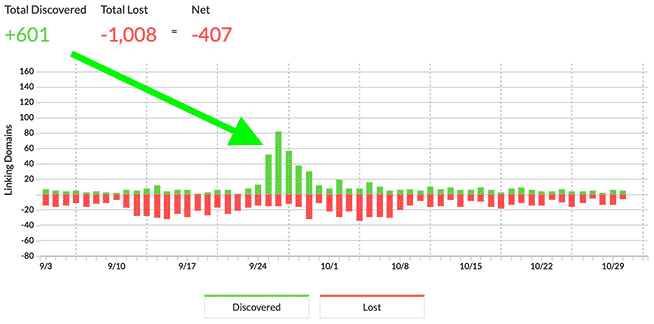
This could mean two things:
-
- A post has gone viral and lots of sites have linked to Fotolog as a result
- There’s been link building campaign done by Fotolog themselves
To find out what’s going on, we’ll click on one of the days when Fotolog received lots of backlinks.
If we scroll down to look at the links that were discovered my Moz Link Explorer on that particular day, this is what we see:
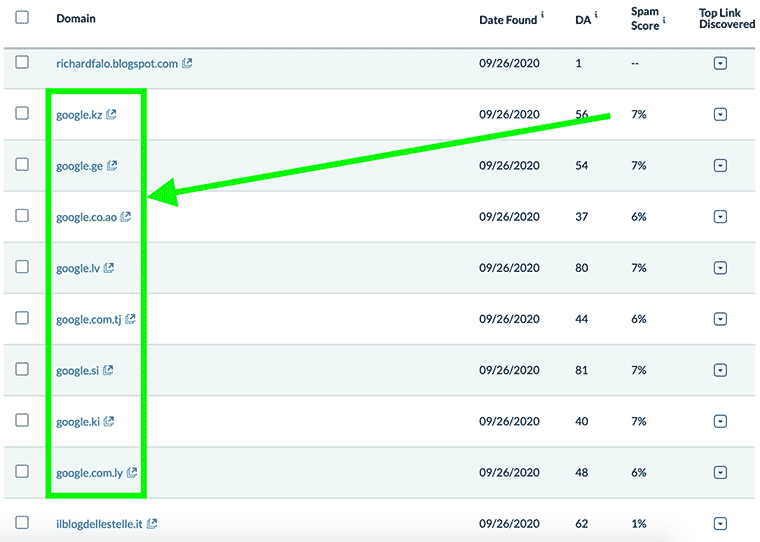
Have you noticed what most of these sites have in common?
Yup, that’s right, most of them are Google owned websites.
If we click any of these links, they all take us to the same type of page which is a redirect page Google uses:

As you’ve probably figured out by now, these are the Google redirect links I was referring to earlier.
And remember…
Although they may boost your domain authority, they’ll have zero impact on your rankings in Google.
Another way of finding out if a site’s domain authority has been manipulated is to head to the “Inbound Links” section in Moz Link Explorer.
Sort by “DA” then in the “Link Type” dropdown menu, tick “follow” and “via redirect”
If the site’s domain authority has been manipulated, then you should see loads of Google related domains labeled as “Redirect Notice”:
UPDATE: You no longer need to tick “via redirect” to locate these Google redirect links
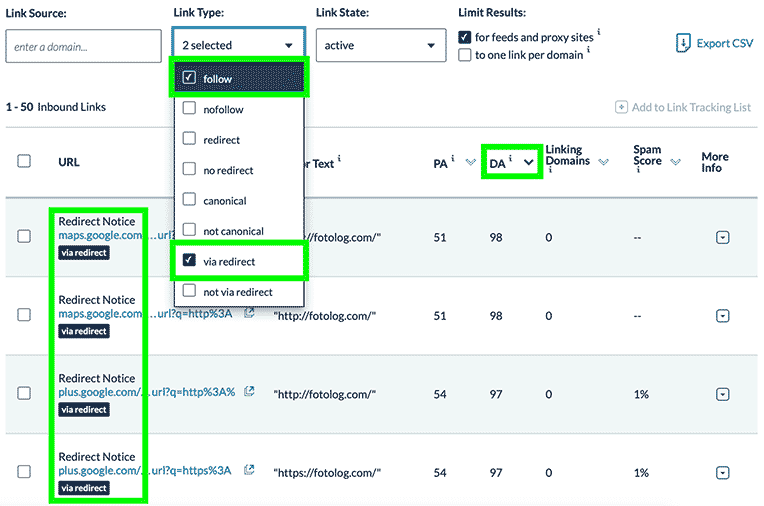
After seeing this, I think it’s save to say Fotolog’s domain authority has been manipulated.
But why would Fotolog.com do this?
Well like I said earlier…
Fotolog makes a big chunk of their money by selling links from their site – and the higher the domain authority – the more they can charge people for these links.
It’s as simple as that, really.
That’s not to say backlinks from Fotolog are worthless by the way, in fact, I’d still consider them quite valuable.
They have some valuable backlinks from authority websites like BBC, Huffington Post etc.
However, it appears they was losing links to their site, and as a result, their domain authority was going down.
And when their domain authority was going down, the guest post prices would have to go down as well.
As a result, Fotolog embarked on this campaign so they can keep charging high prices for their guest posts.
So what’s the takeaway?
If you buy backlinks by the truckload like I do, or you’re on the look out for a domain with a high domain authority, it’s essential you do your homework first.
Otherwise, the likely hood of you getting ripped off is sky-high, my friend.
And don’t think this was a one-off or it rarely happens either – this practice is rife.
As it goes, I spoke to one seller last week and who was offering a dofollow backlink on a DA63 website for $117.
To me, that was a fair price to get a contextual dofollow backlink from a quality DA63 website.
If it was everything the seller claimed it was, it would have been really beneficial to my site in multiple ways.
However, after looking at the website in Moz Link Explorer, I noticed something weird…
The domain authority went from a DA11 to a DA63 in just a few months:
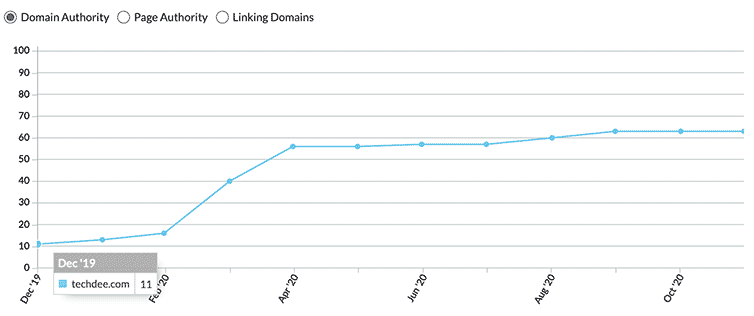
Although possible, it’s extremely unlikely for a site’s domain authority to grow that fast in that timeframe.
so I decided to dig a little deeper – and after some rummaging around – my suspicions were proven correct…
This “DA63” website had nothing but hundreds of Google redirect links pointing back to it.
And like I keep saying…
These Google redirect links have zero value when it comes to ranking your site in the search engines.
This is why you need to analyse these domains you’re buying or getting backlinks from.
If I’d taken this guy’s word for it, I would have been ripped off and left with a worthless backlink that would have zero affect on my site’s rankings in Google.
So if you’re buying backlinks or seen a high authority domains you’re interested in, make sure to do your due diligence first.
Otherwise, you could end up buying junk backlinks and domains at premium prices that yield zero results in Google.
Anyway, what’s your take on this?
Let me know down below and we’ll get the conversation rollin’.
Till then, stay awesome my friend 🙂
James Scholes
Avoid Domain Authority Manipulation When Buying Domains & Backlinks [SCAM WARNING]


4 Comments
ColeN
This is interesting point. The method used is pinging. Pinging is useful in a way to notify the search bot to come index the site, but doing it regularly I doub’t it will have any meaning. Backlinks will be obtained but on short term (few months at most). Unfortunately there are services that just not ping the URL to the search engines only but hundreds (and even thousands) other sites like: PBNs, directories, FFA and other murky places that might but in most cases hurt SEO.
James Scholes
Hey Cole,
I think you’ve got this mixed up with another backlinking method.
This domain authority manipulation technique has absolutely nothing to do with pinging whatsoever.
This is all about getting redirect backlinks from Google that increases your domain authority but has zero effect on your rankings in the search engines.
James Scholes
Kumar Kinshuk
Hi, I have shared the details and have confirmed my email a/c as per your process for seeing your $688 video. However, I am unable to open the video. Kindly help.
Regards,
Kinshuk
James Scholes
Hi Kumar,
I’ve looked into it and it appears you’ve received the email and clicked the link to the free training.
When you clicked the link, it should take you to a page where you can watch the training via a Youtube video at the top of the page.
Just watch that training as that will walk you step by step through the entire process from start to finish.
If you need any further assistance, reply to the email you received when you opted in and I’ll get back to you ASAP.
Hope this helps anyway 🙂
James Scholes
Leave A Response